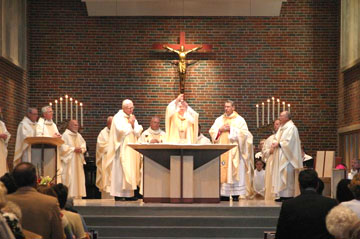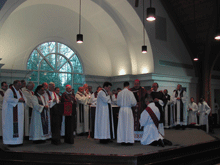42. Then the priest goes to the altar and takes the proper offerings; he raises his eyes to heaven and his hands with the offerings, and prays to the Lord, then places the offerings on the altar.
43. Similarly he offers the wine.
44. The deacons go behind the priest and arrange themselves by rank, and the subdeacons go behind the altar and place themselves by rank, while the priests stand in order before the altar.
45. Then the celebrating priest, with the other priests on his right and left, offers a prayer.
46. He inclines his face to the earth and says the prayer in secret, with no one else able to hear it, until he arrives at the words: "through all ages of ages," and all reply, "Amen."
47. Immediately he says, "The Lord be with you," then "Lift up your hearts," then "Let us give thanks to the Lord our God," and then he commences the preface; he lifts his voice and proclaims the preface so that it may be heard by virtually all.
|
 |


